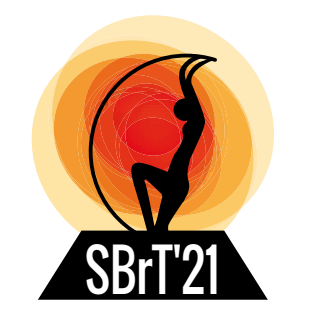
XXXIX Simpósio Brasileiro de Telecomunicações e Processamento de Sinais

Simulador de Código Livre Aplicado em Redes Ópticas com Multiplexação por Divisão Espacial
Gileno Guerra-Júnior, Eloisa Sarmento, Mariana Costa, Helder A. Pereira
DOI: 10.14209/sbrt.2021.1570726248
Keywords: Código Livre Rede Óptica Multiplexação por Divisão de Comprimento de Onda Multiplexação por Divisão Espacial
Abstract
The increased demand for traffic on the networks has driven the development of technologies capable of serving them efficiently. Based on this premise, elastic optical networks (EON) brought flexibility in the establishment of calls compared to wavelength division multiplexing (WDM) optical networks. In recent years, space division multiplexing (SDM) technology has been gaining space in the literature in order to explore the spatial dimensions in optical fibers. In this context, this paper proposes an extension of an open source simulator, used in WDM optical networks and EONs, for the scenario of SDM/WDM and SDM/EON. For this, it considers the impact of physical penalties along the propagation of optical signals (losses and gains in devices, amplified spontaneous emission noise and intercore crosstalk). Validations in different scenarios, using simulators available in the literature and computational tools, were performed in order to demonstrate the robustness of the new simulator.Download
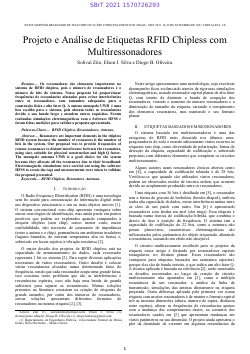
Projeto e Análise de Etiquetas RFID Chipless com Multiressonadores
Solival Zito, Diogo Oliveira, Elson Silva
DOI: 10.14209/sbrt.2021.1570726293
Keywords: RFID Chipless Ressonadores Antenas
Abstract
Resonators are important elements in the chipless RFID system because the number of resonators is the number of bits in the system. Our proposal was to provide frequencies of remote resonances to distant interference between the resonators, using sizes suitable for physical construction and high Q factor. The monopole antenna UWB is a good choice for the system because they allocate all the resonances due to their broadband.Download
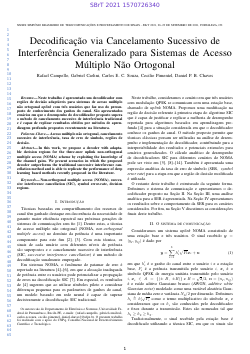
Decodificação via Cancelamento Sucessivo de Interferência Generalizado para Sistemas de Acesso Múltiplo Não Ortogonal
Rafael Campello, Gabriel Carlini Monte da Silva, Carlos Eduardo Souza, Cecilio Pimentel, Daniel P B Chaves
DOI: 10.14209/sbrt.2021.1570726340
Keywords:
Abstract
Neste trabalho é apresentado um decodificador com regiões de decisão adaptáveis para sistemas de acesso múltiplo não ortogonal uplink com três usuários que faz uso do pressuposto de conhecimento dos ganhos do canal. São apresentados cenários em que o desempenho do decodificador proposto supera o método de cancelamento sucessivo de interferência tradicional e é capaz de replicar resultados obtidos por métodos de aprendizagem profunda propostos recentemente na literatura.Download
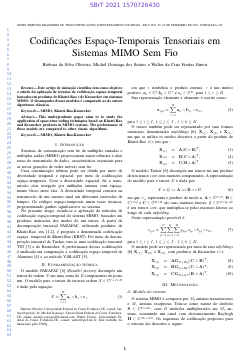
Codificações Espaço-Temporais Tensoriais em Sistemas MIMO Sem Fio
Bárbara Oliveira, Michel dos Santos, Walter da Cruz Freitas Jr.
DOI: 10.14209/sbrt.2021.1570726430
Keywords: MIMO Khatri-Rao Kronecker
Abstract
Este artigo de iniciação científica tem como objetivo o estudo da aplicação de técnicas de codificação espaço-temporal baseados em produtos de Khatri-Rao e de Kronecker em sistemas MIMO. A performance desses modelos é comparada em relação a outros algoritmos clássicos.Download
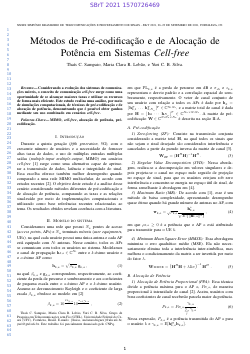
Métodos de Pré-codificação e de Alocação de Potência em Sistemas Cell-free
Thais Cavalcante Sampaio, Maria Clara R. Lobão, Yuri C. B. Silva
DOI: 10.14209/sbrt.2021.1570726469
Keywords: MIMO cell-free alocação de potência pré-codificação
Abstract
Considerando a evolução dos sistemas de comunicações móveis, o conceito de comunicação cell-free surge como uma oportunidade de se alcançar maiores taxas e utilizar os recursos de forma mais eficiente. Este estudo realiza uma análise, através de simulações computacionais, de técnicas de pré-codificação e de alocação de potência, demonstrando que é possível obter ganhos através do seu uso combinado em cenários cell-free.Download
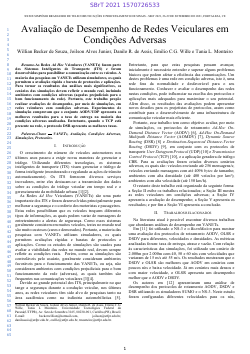
Avaliação de Desempenho de Redes Veiculares em Condições Adversas
Willian de Souza, Joilson Alves Junior, Danilo Renato de Assis, Emilio C G Wille, Tania Monteiro
DOI: 10.14209/sbrt.2021.1570726533
Keywords: VANETs Avaliação Condições Adversas Protocolos
Abstract
As Redes Ad Hoc Veiculares (VANETs) fazem parte dos Sistemas Inteligentes de Transporte (ITS) e foram desenvolvidas para possibilitar a comunicação entre os veículos. A maioria das pesquisas em VANETs utilizam simuladores, os quais permitem a avaliação rápida e barata de protocolos e aplicações. Para tornar os resultados das análises mais significativos, os cenários das simulações devem refletir o mundo real, incluindo ambientes com condições adversas (aquelas prejudiciais para o bom funcionamento da rede). Portanto, este trabalho propõe realizar avaliações de desempenho, por meio de simulações, em redes veiculares com condições adversas. Experimentos de simulação comprovam que o conjunto AODV/UDP apresenta os melhores resultados para a taxa de entrega na maioria das condições adversas analisadas. Entretanto, quando o TCP está presente na rede, o protocolo DSR apresenta as melhores taxas.Download

Low Overhead Beamtraining for Millimeter-Wave MIMO Systems: Machine Learning Approach Based on Path Parameters
Antonio Regilane Paiva, Walter da Cruz Freitas Jr., Yuri C. B. Silva
DOI: 10.14209/sbrt.2021.1570726547
Keywords: Beamtracking Kalman Filter Machine Learning NLOS
Abstract
Machine learning has been widely used as a solution to deal with beam management training overhead for 5th generation wireless communication systems. However, the types of information adopted for the training base have not been sufficient to achieve a robust intelligent system. Channel path parameters provide valuable information that can increase the accuracy of this type of solution. In this work, we present initial results of the application of the Kalman filter to estimate path parameters aiming at a robust training base. Simulated results in 3D ray-tracing show promising results on obstruction conditions.Download
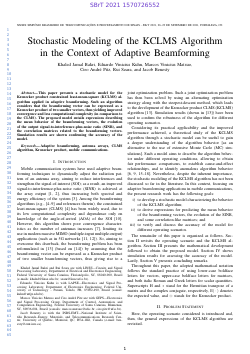
Stochastic Modeling of the KCLMS Algorithm in the Context of Adaptive Beamforming
Khaled Jamal Bakri, Eduardo V Kuhn, Marcos Matsuo, Ciro André Pitz, Rui Seara, Jacob Benesty
DOI: 10.14209/sbrt.2021.1570726552
Keywords: Adaptive beamforming antenna arrays CLMS algorithm Kronecker product
Abstract
This paper presents a stochastic model for the Kronecker product constrained least-mean-square (KCLMS) algorithm applied in adaptive beamforming. Such an algorithm considers that the beamforming vector can be expressed as a Kronecker product of two smaller vectors, thus yielding improved convergence and less computational complexity (in comparison to the CLMS). The proposed model entails expressions describing the mean behavior of the beamforming vectors, the evolution of the output signal-to-interference-plus-noise ratio (SINR), and the correlation matrices related to the beamforming vectors. Simulation results are shown confirming the accuracy of the model.Download
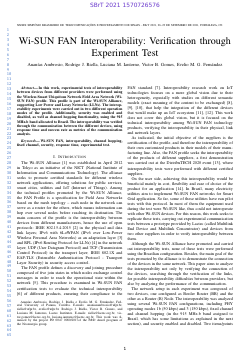
Wi-SUN FAN Interoperability: Verification through Experiment Test
Ananías Ambrosio, Rodrigo Riella, Luciana Iantorno, Victor B. Gomes, Evelio Fernandez
DOI: 10.14209/sbrt.2021.1570726576
Keywords: Wi-SUN FAN interoperability channel hopping fixed channel
Abstract
In this work, experimental tests of interoperability between devices from different providers were performed using the Wireless Smart Ubiquitous Network Field Area Network (Wi-SUN FAN) profile. This profile is part of the Wi-SUN Alliance, supporting Low Power and Lossy Networks (LLNs). The interoperability experiments were carried out in two different operation modes of the profile. Additionally, security was enabled and disabled, as well as channel hopping functionality, using the 915 MHz-b band allocated to Brazil. The interoperability was verified through the communication between the different devices, using response time and success rate as metrics of the communication analysis.Download

Applying the majority voting rule in acoustic detection and classification of drones
Rigel Fernandes, José Antonio Apolinário Jr., António Ramos, José de Seixas
DOI: 10.14209/sbrt.2021.1570726624
Keywords: UAV audio processing threat detection target classification
Abstract
This paper discusses an approach to target detection and classification based on acoustic signals collected using one single microphone. We divide the problem into two parts, namely feature extraction and target detection and classification. We use an optimization step based on human auditory uncertainty. We employ a majority voting rule for every set of feature vectors, i.e., an estimate is only performed if the majority agrees. We conducted experiments using a single channel of the AIRA-UAS dataset, a public database of raw drone noises collected with an array of microphones mounted on a drone. This dataset comprises many different kinematics, with different spectra. The features we used are based on the Mel-Frequency Cepstral Coefficients (MFCC) and the Short-Time Fourier Transform of raw signals. We used the k-Nearest Neighbors algorithm for classification and adopted the cross-validation strategy to evaluate the method. We observed that the use of MFCC results in less biased estimations, which favors the voting strategy. The detection in the proposed method reached a probability of false positive near 0%, even with a small set of votes, and a classification accuracy of 99.1%. These metrics satisfy the requirements of most civilian and military applications.Download